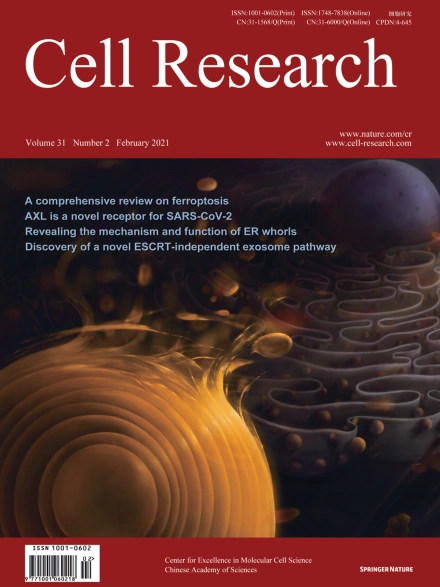
Advanced Search
Submit Manuscript
Advanced Search
Submit Manuscript
Volume 31, No 2, Feb 2021
ISSN: 1001-0602
EISSN: 1748-7838 2018
impact factor 17.848*
(Clarivate Analytics, 2019)
Volume 31 Issue 2, February 2021: 126-140 |
AXL is a candidate receptor for SARS-CoV-2 that promotes infection of pulmonary and bronchial epithelial cells
Shuai Wang1,2,3 , Zongyang Qiu1,2,3 , Yingnan Hou1,2,3 , Xiya Deng1,2,3 , Wei Xu4 , Tingting Zheng1,2,3 , Peihan Wu1,2,3 , Shaofang Xie1,2,3 , Weixiang Bian1,2,3 , Chong Zhang5 , Zewei Sun5 , Kunpeng Liu6 , Chao Shan6 , Aifu Lin7 , Shibo Jiang4 , Youhua Xie4 , Qiang Zhou1,2,3 , Lu Lu4,* , Jing Huang1,2,3,* , Xu Li1,2,3,*
1Key Laboratory of Structural Biology of Zhejiang Province, School of Life Sciences, Westlake University, Hangzhou, Zhejiang 310024, ChinaThe current coronavirus disease 2019 (COVID-19) pandemic presents a global public health challenge. The viral pathogen responsible, severe acute respiratory syndrome coronavirus 2 (SARS-CoV-2), binds to the host receptor ACE2 through its spike (S) glycoprotein, which mediates membrane fusion and viral entry. Although the role of ACE2 as a receptor for SARS-CoV-2 is clear, studies have shown that ACE2 expression is extremely low in various human tissues, especially in the respiratory tract. Thus, other host receptors and/or co-receptors that promote the entry of SARS-CoV-2 into cells of the respiratory system may exist. In this study, we found that the tyrosine-protein kinase receptor UFO (AXL) specifically interacts with the N-terminal domain of SARS-CoV-2 S. Using both a SARS-CoV-2 virus pseudotype and authentic SARS-CoV-2, we found that overexpression of AXL in HEK293T cells promotes SARS-CoV-2 entry as efficiently as overexpression of ACE2, while knocking out AXL significantly reduces SARS-CoV-2 infection in H1299 pulmonary cells and in human primary lung epithelial cells. Soluble human recombinant AXL blocks SARS-CoV-2 infection in cells expressing high levels of AXL. The AXL expression level is well correlated with SARS-CoV-2 S level in bronchoalveolar lavage fluid cells from COVID-19 patients. Taken together, our findings suggest that AXL is a novel candidate receptor for SARS-CoV-2 which may play an important role in promoting viral infection of the human respiratory system and indicate that it is a potential target for future clinical intervention strategies.
https://doi.org/10.1038/s41422-020-00460-y